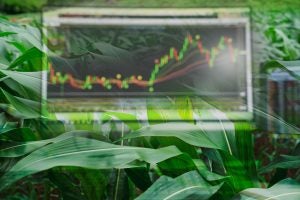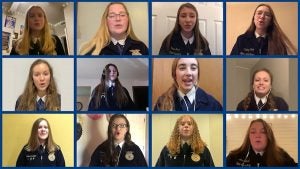A lingering pandemic and its continued economic impact raises questions about what 2021 will look like for farmers
Coming off a rough year, everyone has been looking toward 2021 with mad hope. While there are many unknowns, Americans working in the food and agricultural sectors have some reasons to be cautiously optimistic.
The big questions agribusinesses large and small have revolve around market forecasts and international trade relationships. And of course, let us not forget we are all still concerned about public health.
The arrival of the coronavirus vaccine on U.S. soil in mid-December was seen as a ray of hope for many. While prioritized for healthcare workers and at-risk populations, rural America also wants its share — but will it be the long hoped for solution?
Then there’s the million-dollar question: How long until we see the return of old-fashioned in-person interaction?

Rural American healthcare
Coming into 2021, we have a few advantages and tools at our disposal that we didn’t have starting out in 2020. We’ve had nearly a full year of experience, observation, and now a vaccine to battle COVID.
Being essential workers, farmers and food business workers are certainly on the radar of vaccine access vaccine, said Dr. Chris Huffer.
Huffer is a pulmonologist and fourth-generation farmer who works in a rural clinic in one of Indianapolis’ surrounding counties.
He reported that his clinic is receiving about 2,000 vaccines directly from Pfizer each week as part of the Phase 1 vaccination protocol. Their first order is to get all healthcare workers and hospital employees vaccinated, along with those living and working in nursing homes.
Phase 2 will be adults with pre-existing conditions and individuals over 65 years old. If all goes according to plan, this will begin early spring.
Afterward, the vaccine will hopefully be made accessible to farmers and other essential workers in the food and food service industries.
“I hope it’s going be in high demand,” Huffer said of the vaccine. “There is this kind of a dichotomy between folks that are very interested and excited about the vaccine. But there’s also a lot of skepticism because of the speed at which the vaccine was trialed and launched.”
He noted part of what accelerated the vaccine’s development was the number of cases. This allowed the trials to be done very quickly and be proven effective.
Additionally, lots of healthcare workers will have had the vaccine before most of the rest of the population.
Rural communities may be slower to receive the vaccine because of the perception COVID isn’t as prevalent in those areas.
“Rural America is not spared from COVID-19,” he said, noting his county of just 20,000 was recently declared red from number of cases. “Everybody is still going to the grocery store, everybody’s still got to go to church and stuff like that.”

Market outlook
The food supply chain, and its financial components, is on the radar of agriculturalists and the public alike.
Commodities tanked early last year, particularly March through May, but then rebounded. Part of this was due to incredible Chinese demand, explained Mark Gold, managing director of Top Third Ag Marketing, a division of StoneX.
What 2021 will look like as a whole depends on many factors.
“New crop bean prices are close to $11, and I think farmers are going to be very willing sellers and plant a lot of beans based on that price,” he said in an interview earlier this month.
However, Gold went on to say weather will also play a role, depending on how it impacts other China exporters like Brazil. How many exports they end up fulfilling could drive U.S. prices either up or down significantly.
John Newton, Chief Economist for the American Farm Bureau Federation, also stressed the significance of China. This extends to other goods as well.
“China’s been buying a lot of animal protein products grains and oil seeds,” he said. “That’s helped to boost prices. I think as we see a vaccine implemented around the world will certainly help those economies recover and, hopefully, will help to boost demand globally.”
Similarly, Gold noted how much influence the vaccine has over COVID in the next six months, especially, will be a good indicator to weigh global and domestic market demands.
And finally, another very important variable is the newly installed Biden administration.
“We want to see a free flow of commodities, and the Biden administration seems to want to move in a positive direction on that front,” Gold said. “Between a new administration, China, COVID and the weather, it’s just a fool’s game to try and really guess where these prices are going.”
Besides a new presidential administration, Newton noted we have other new leadership coming to Capitol Hill. In all, there is about 85 years of ag policy experience that will be replaced.
“Finding new champions for agriculture, will be very important … with both parties working to find and meet the needs of agriculture,” he said of AFBF’s work in the new year.
Fortunately, with more personal protective equipment and ongoing social distancing protocols at food processing facilities, further amplified with the vaccine, there is hope suppliers will be able to stay up and running smoothly.
“If that’s the case, I think we’ll avoid any type of massive disruptions in the supply chain, but again,” Newton cautioned, “that’s your immediate challenge with the rapidly rising number of cold cases that we’ve seen in recent weeks.”

Events
Last year a lot of annual in-person events, long staples of the ag community, were either canceled or moved to virtual platforms. As with much else, how many of these are able to resume their standard platforms is going to heavily depend on how COVID continues to either spread or decline in the coming months.
This year’s National Farm Machinery Show was pushed back and slated to be held March 31 through April 3 in the hopes of being able to be an in-person event.
World Dairy Expo, not until September 28 through October 2, is crossing its fingers things will be able to resume as planned.
“During 2020, many of the National FFA Organization’s events went virtual — including the 93rd National FFA Convention, this past October,” Kristy Meyer, National FFA Communications Manager, said in a statement to AGDAILY. “We are hoping to once again have in-person events later this year, and as we look forward to October of 2021, at this time, we are planning to have an in-person event in Indianapolis.”
We could go on with a laundry list of other events, but you get the picture. Overall, the next few months will be very telling of how rural American will fare compared to last year. Farmers and other ag businesses are encouraged to keep a watchful (but cautiously optimistic!) eye on news and politics happening in the world.
Jaclyn Krymowski is a recent graduate of The Ohio State University with a major in animal industries and minor in agriculture communications. She is an enthusiastic “agvocate,” professional freelance writer, and blogs at the-herdbook.com.



